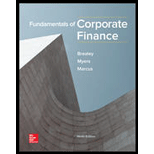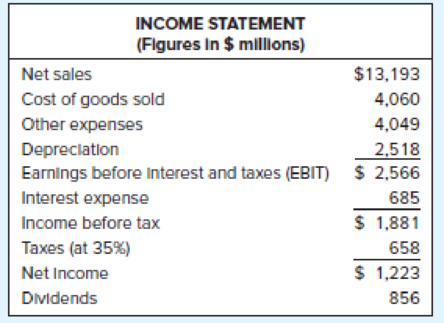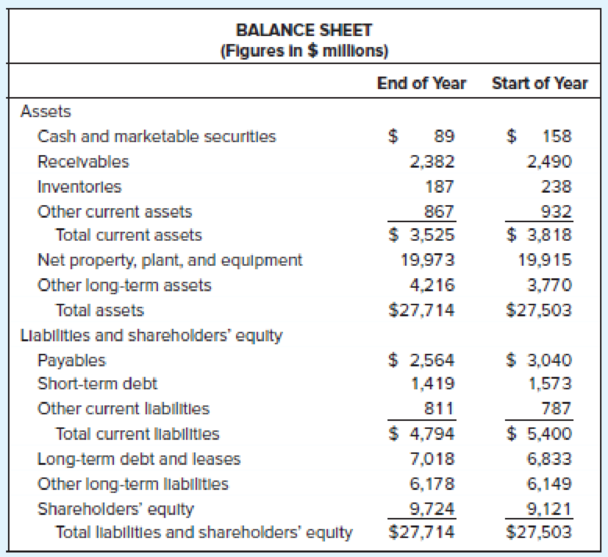
Financial Ratios. Here are simplified financial statements for Phone Corporation in a recent year:


Calculate the following financial ratios for Phone Corporation using the methodologies listed for each part:
- a.
Return on equity (use averagebalance sheet figures) - b.
Return on assets (use average balance sheet figures) - c. Return on capital (use average balance sheet figures)
- d. Days in inventory (use start-of-year balance sheet figures)
- e. Inventory turnover (use start-of-year balance sheet figures)
- f. Average collection period (use start-of-year balance sheet figures)
- g. Operating profit margin
- h. Long-term debt ratio (use end-of-year balance sheet figures)
- i. Total debt ratio (use end-of-year balance sheet figures)
- j. Times interest earned
- k. Cash coverage ratio
- l. Current ratio (use end-of-year balance sheet figures)
- m. Quick ratio (use end-of-year balance sheet figures)
a.
To compute: Return on equity (ROE)
Explanation of Solution
The formula to calculate return on equity is as follows:
The calculation of return on equity is as follows:
Hence, the ROE is 13%
b.
To compute: Return on assets (ROA)
Explanation of Solution
The formula to calculate return on asset is as follows:
The calculation of return on capital is as follows:
Hence, the ROA is 6.04%
c.
To compute: Return on capital (ROC)
Explanation of Solution
The formula to calculate return on capital is as follows:
The calculation of return on equity is as follows:
Hence, the ROC is 10.20%
d.
To compute: Days in inventory.
Explanation of Solution
The formula to calculate days in inventory is as follows:
.
The calculation of days in inventory is as follows:
Hence, the days in inventory is 21.40 days
e.
To compute: Inventory turn over
Explanation of Solution
The formula to calculate inventory turnover is as follows:
The calculation of inventory turnover is as follows:
Hence, the inventory turnover is 19.11
f.
To compute: Average collection period(ACP)
Explanation of Solution
The formula to calculate average collection period is as follows:
The calculation of average collection period is as follows:
Hence, the ACP is 68.89 days.
g.
To compute: Operating profit margin (OPM)
Explanation of Solution
The formula to calculate operating profit margin is as follows:
The calculation of operating profit margin is as follows:
Hence, the OPM is 12.64%
h.
To compute: Long term debt ratio
Explanation of Solution
The formula to calculate operating profit margin is as follows:
The calculation of long term debt ratio is as follows:
Hence the long term debt ratio is 0.42
i.
To compute: Total debt ratio
Explanation of Solution
The formula to calculate total debt ratio is as follows:
The calculation of total debt ratio is as follows:
Hence the total debt ratio is 0.65
j.
To compute: Times interest earned
Explanation of Solution
The formula to calculate times interest earned is as follows:
The calculation of times interest earned is as follows:
Hence the time interest earned is 3.75
k.
To compute: Cash coverage ratio
Explanation of Solution
The formula to calculate cash coverage ratio is as follows:
The calculation of cash coverage ratio is as follows:
Hence the cash coverage ratio is 7.42
l.
To compute: Current ratio
Explanation of Solution
The formula to calculate current ratio is as follows:
The calculation of current ratio is as follows:
Hence the current ratio is 0.74
m.
To compute: Quick ratio
Explanation of Solution
The formula to calculate quick ratio is as follows:
The calculation of quick ratio is as follows:
Hence the quick ratio is 0.52
Want to see more full solutions like this?
Chapter 4 Solutions
Fundamentals of Corporate Finance (Mcgraw-hill/Irwin Series in Finance, Insurance, and Real Estate)
- It is now January 1. You plan to make a total of 5 deposits of $500 each, one every 6 months, with the first payment being made today. The bank pays a nominal interest rate of 14% but uses semiannual compounding. You plan to leave the money in the bank for 10 years. Round your answers to the nearest cent. 1. How much will be in your account after 10 years? 2. You must make a payment of $1,280.02 in 10 years. To get the money for this payment, you will make five equal deposits, beginning today and for the following 4 quarters, in a bank that pays a nominal interest rate of 14% with quarterly compounding. How large must each of the five payments be?arrow_forwardDon't used hand raiting and don't used Ai solutionarrow_forwardDon't used Ai solution and don't used hand raitingarrow_forward
- (d) Estimate the value of a share of Cisco common stock using the discounted cash flow (DCF) model as of July 27, 2019 using the following assumptions Assumptions Discount rate (WACC) Common shares outstanding 7.60% 5,029.00 million Net nonoperating obligations (NNO) $(8,747) million NNO is negative, which means that Cisco has net nonoperating investments CSCO ($ millions) DCF Model Reported 2019 Forecast Horizon 2020 Est. 2021 Est. 2022 Est. 2023 Est. Terminal Period Increase in NOA FCFF (NOPAT - Increase in NOA) $ 1241 1303 1368 10673 11207 11767 1437 $ 12354 302 ✓ Present value of horizon FCFF 9918 9679 9445 ✔ 0 × Cum. present value of horizon FCFF $ 0 × Present value of terminal FCFF 0 ☑ Total firm value 0 ☑ NNO -8747 ✓ Firm equity value $ 0 ☑ Shares outstanding (millions) 5029 Stock price per share $ 40.05arrow_forwardDon't used hand raiting and don't used Ai solutionarrow_forwardDon't used hand raiting and don't used Ai solutionarrow_forward
- Don't used Ai solution and don't used hand raitingarrow_forwardQ1: Blossom is 30 years old. She plans on retiring in 25 years, at the age of 55. She believes she will live until she is 105. In order to live comfortably, she needs a substantial retirement income. She wants to receive a weekly income of $5,000 during retirement. The payments will be made at the beginning of each week during her retirement. Also, Blossom has pledged to make an annual donation to her favorite charity during her retirement. The payments will be made at the end of each year. There will be a total of 50 annual payments to the charity. The first annual payment will be for $20,000. Blossom wants the annual payments to increase by 3% per year. The payments will end when she dies. In addition, she would like to establish a scholarship at Toronto Metropolitan University. The first payment would be $80,000 and would be made 3 years after she retires. Thereafter, the scholarship payments will be made every year. She wants the payments to continue after her death,…arrow_forwardCould you please help explain what is the research assumptions, research limitations, research delimitations and their intent? How the research assumptions, research limitations can shape the study design and scope? How the research delimitations could help focus the study and ensure its feasibility? What are the relationship between biblical principles and research concepts such as reliability and validity?arrow_forward
- What is the concept of the working poor ? Introduction form. Explain.arrow_forwardWhat is the most misunderstanding of the working poor? Explain.arrow_forwardProblem Three (15 marks) You are an analyst in charge of valuing common stocks. You have been asked to value two stocks. The first stock NEWER Inc. just paid a dividend of $6.00. The dividend is expected to increase by 60%, 45%, 30% and 15% per year, respectively, in the next four years. Thereafter, the dividend will increase by 4% per year in perpetuity. Calculate NEWER’s expected dividend for t = 1, 2, 3, 4 and 5. The required rate of return for NEWER stock is 14% compounded annually. What is NEWER’s stock price? The second stock is OLDER Inc. OLDER Inc. will pay its first dividend of $10.00 three (3) years from today. The dividend will increase by 30% per year for the following four (4) years after its first dividend payment. Thereafter, the dividend will increase by 3% per year in perpetuity. Calculate OLDER’s expected dividend for t = 1, 2, 3, 4, 5, 6, 7 and 8. The required rate of return for OLDER stock is 16% compounded annually. What is OLDER’s stock price? Now assume that…arrow_forward
 Managerial AccountingAccountingISBN:9781337912020Author:Carl Warren, Ph.d. Cma William B. TaylerPublisher:South-Western College Pub
Managerial AccountingAccountingISBN:9781337912020Author:Carl Warren, Ph.d. Cma William B. TaylerPublisher:South-Western College Pub Managerial Accounting: The Cornerstone of Busines...AccountingISBN:9781337115773Author:Maryanne M. Mowen, Don R. Hansen, Dan L. HeitgerPublisher:Cengage Learning
Managerial Accounting: The Cornerstone of Busines...AccountingISBN:9781337115773Author:Maryanne M. Mowen, Don R. Hansen, Dan L. HeitgerPublisher:Cengage Learning Cornerstones of Financial AccountingAccountingISBN:9781337690881Author:Jay Rich, Jeff JonesPublisher:Cengage Learning
Cornerstones of Financial AccountingAccountingISBN:9781337690881Author:Jay Rich, Jeff JonesPublisher:Cengage Learning Financial AccountingAccountingISBN:9781337272124Author:Carl Warren, James M. Reeve, Jonathan DuchacPublisher:Cengage Learning
Financial AccountingAccountingISBN:9781337272124Author:Carl Warren, James M. Reeve, Jonathan DuchacPublisher:Cengage Learning Financial And Managerial AccountingAccountingISBN:9781337902663Author:WARREN, Carl S.Publisher:Cengage Learning,
Financial And Managerial AccountingAccountingISBN:9781337902663Author:WARREN, Carl S.Publisher:Cengage Learning,





